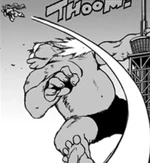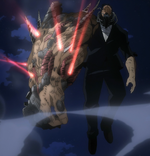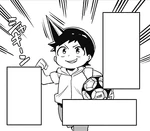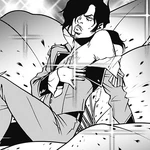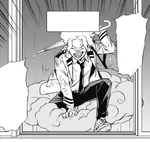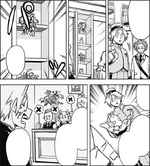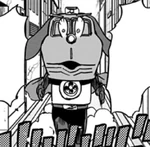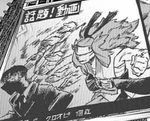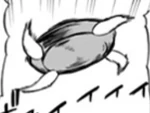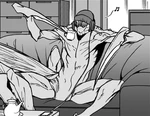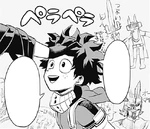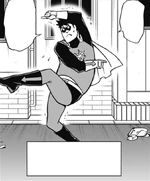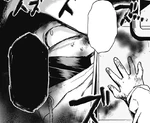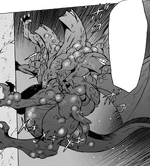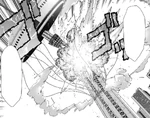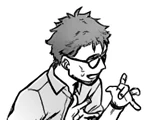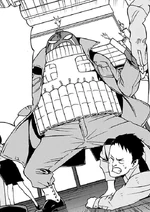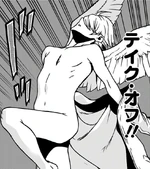A Quirk (
Along with being unique to each user, Quirks are sorted into multiple categories. Quirk users are also limited to only developing one ability and are thus unable to achieve any other through natural means.
History[]

The first recognized Quirk.
The earliest known instance of a human having superpowers was a female sex worker, who would later become the mother of twin boys, All For One and Yoichi Shigaraki. Her Quirk was Spearlike Bones, but it only manifested as hardened growths on her left arm. She died during childbirth by a riverbank, her life force sucked away by a fetal All For One, without ever truly knowing about her ability.[1] A year after her sons were born, the first superpower ever to be officially recorded was manifested by a newborn baby in Qing Qing City, China with the ability to radiate light from its body. After this phenomenon, many people around the world began to manifest different kinds of superpowers,[2] and not just at birth, some people showed signs of powers in puberty. These powers became known as "Meta Abilities".

The advent of the Quirks led society into chaos.
While the cause of this phenomenon is unknown, one research group looking into the matter hypothesized that it was caused by the spread of a previously unknown novel disease carried by mice, while others theorized that it was actually a natural evolution of the human race, however, to date, there is no hard evidence to support any of these theories.[3] The aforementioned research group announced to the public that those with Meta Abilities were a subbranch of humanity with new genetic factors.

The era of Vigilantes.
The dawn of this extraordinary era was marred by a breakdown of society caused by the sudden onslaught of criminals empowered by their newfound "superpowers" and ordinary people being prejudiced against the new minority. The announcement by the researchers proved to be reckless and premature as the statement divided people, and caused chaos to grow. As a result, Anti-Meta groups rose up with the objective of exterminating those with abilities.
The Luminescent Baby took advantage of their fame as the first recorded Quirk user, attempting to rally a following that preached a return to a peaceful and stable society. They had 10 million followers at one point, but was later murdered out of jealousy for all the attention and admiration they were getting by a powerful supervillain who would later be known as All For One.[1]
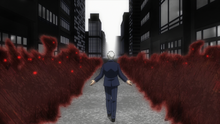
All For One becomes a symbol of unity, gathering followers.
As chaos and unrest ensued due to the outbreak of Meta Abilities, ordinary civilians decided to take matters into their own hands to bring order to society, and thus the first "Heroes" appeared in the form of Vigilantes, beginning the Vigilantes Era.[4]
During this time period, All For One became a symbol of unity in society. He used his own Meta Ability to remove Meta Abilities from those who did not want them and give them to those that did. His actions under the guise of returning society to its prior state of humanity, when in reality, he was gathering followers who were loyal to him, allowing him to act out his ulterior motives.[5]
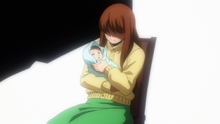
A mother's unconditional love led to the birth of the term "Quirk".
At some point, a woman gave birth to a son named Chikara Yotsubashi. As Chikara grew up, he faced a lot of discrimination and abuse for having a Meta Ability. His mother supported him, stating that her son's Meta Ability is "just a Quirk of his". Although at the time, her message was scorned and even led to her murder, decades later, "Quirk" became the most common term for such Meta Abilities, and she retroactively became known as The Mother of Quirks.[6]
As society adapted to the new status quo, the Police Force moved to prioritize leadership and to maintain the status quo, and as such, decided not to use Quirks as weapons. To fill that void, the profession of crime-fighting Quirk users, Pro Heroes, began to exist, starting in Rhode Island, USA, which caused the Vigilantes to slowly disappear. Authorizing the use of powers that could so easily kill, however, was a greatly criticized decision at first, but eventually became accepted as a legitimate occupation. This became known as the "Advent of the Extraordinary".[7]
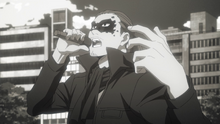
Destro preaching that Quirks should be used freely.
With the proliferation of Quirks, the government began to regulate their use. A group of Quirk users known as the Meta Liberation Army, led by Chikara under the alias, Destro, had tried to stop the passing of regulations that would restrict Quirk usage, believing that free use of Quirks is a basic human right. They rebelled against the governments of a number of nations for several years before meeting their defeat. Chikara himself was imprisoned and wrote a biographical book, Meta Liberation War, detailing his ideals over liberating Quirks. After getting his writing published, Chikara committed suicide, but his legacy would continue over the years with members and supporters of the Meta Liberation Army operating from the shadows.[8]
Currently, roughly 80% of the people who make up the global population possess a Quirk, and that percentage continues to increase.[2] According to Yoichi Shigaraki, the number of individuals without a Quirk has been rapidly declining in population, indicating that now less than 20% of the world's population is Quirkless (無個性 Mu Kosei?, lit. "No Individuality").
Information[]

The exam that diagnosed Izuku Midoriya as Quirkless.
Quirks are said to be the next stage of evolution in the human race. It is possible, though rudimentary, to diagnose a person as possessing or lacking a Quirk by analyzing the presence or absence of an extra joint in their pinky toe. People with only one joint tend to develop a Quirk, while having two joints usually indicates that the person is Quirkless. The lack of the extra joint makes a person's body more "streamlined", a secondary aspect of human evolution brought about by the emergence of Quirks.[2]
A person's Quirk will normally manifest anytime before the age of four, sometimes even straight after birth, such was the case with Present Mic[9] and the Luminescent Baby; although, there are late bloomers who don't develop their power until a bit later in life. There are also records of people not developing their powers until they hit puberty, and Izuku Midoriya was able to hide the truth of receiving One For All by claiming that he was a late bloomer, showing that it is possible for someone not to develop their Quirk until their teenage years or perhaps even later. In one very early case in the history of Quirks, Yoichi's Quirk Bestowal did not make itself known for most of his life due to his malnourished body causing it to be weak and unformed, leading to the belief that he was Quirkless.
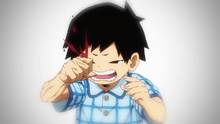
Eijiro Kirishima's Quirk first manifesting as a child.
A Quirk's manifestation tends to happen very suddenly, often to the child's surprise. Eijiro Kirishima's Hardening Quirk first manifested in the middle of the night when he needed the toilet, and resulted in one of his hands accidentally cutting his right upper eye. That said, there can be precursors to a Quirk manifesting as well, such as Tenko Shimura feeling a sudden pain in one of his arms the evening before his Quirk fully manifested.
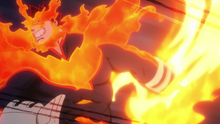
Fire manipulation: A more common and widespread type of power.
While Quirks are unique from person to person, some powers are more common and widespread than others, such as fire or water manipulation and the power to grow to gigantic sizes. On the other hand, Quirks such as spatial warping and regenerative healing are very rare.
Furthermore, not all Quirks are singular abilities, as there are some that can have multiple powers. Kaina Tsutsumi's Quirk allows her to protrude a rifle from her right elbow, but she can also mould pieces of her hair like epoxy putty and shape them into any kind of bullet.[10] Tsuyu Asui's Frog Quirk gives her the physiology of said creature, granting her the many abilities of a frog such as an extendable tongue, great leg strength and leaping ability, camouflage, etc.[11] In rarer cases, a single Quirk can take the form of multiple abilities that are completely different from each other, giving the impression of having more than one Quirk; Shoto Todoroki possesses a Quirk that is a perfect combination of his father and mother's fire and ice powers respectively, essentially giving him two Quirks in one.

Dark Shadow: A Quirk in the shape of a sentient being.
It is even possible, albeit quite rare, for some Quirks to take the form of sentient beings that are connected to their users. Fumikage Tokoyami's Dark Shadow grants him a dark creature that lives inside his body which is capable of speaking and acting by itself, even going against its own user's command on occasion. Rody Soul's eponymous Quirk gives him a small bird-like companion named Pino who acts based on his innermost feelings.[12]
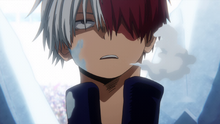
Shoto's overuse of his Quirk gives him frostbite.
Quirks are extensions of a person's bodily functions. As such, they can be trained and worn out. When a person works out their muscles, the muscle fibers are destroyed and new, stronger ones grow back; this same rule applies to Quirks. However, should a Quirk be overused, the user could suffer any of a variety of drawbacks, depending on the nature of the Quirk. These drawbacks are usually simple ailments, such as dry skin or nausea; however, in some cases, the drawback can be much more severe.

Dabi's body unable to handle his own flames, resulting in permanent burns and scarring.
The body of a Quirk user has natural adaptations to protect itself from any damage the Quirk might do to them without these natural defenses. For example, someone who can breathe fire does not burn their mouth when using their ability. However, there are instances where a Quirk doesn't suit the user's body and the body can't handle it. Such conditions can be bypassed through the use of support equipment, such as Yuga Aoyama's belt.[13] Some people simply have a body that is not properly suited for their Quirk, Toya Todoroki for example inherited his mother's tolerance for freezing cold, rather than his father's tolerance for high heat, causing him to easily get burned by his own flames.[14] Some people, such as Nine, have a Quirk that is simply too powerful for the human body to handle, causing them to suffer a massive strain on their body, resulting in chronic pain, cellular degeneration, and even a significantly shortened lifespan.
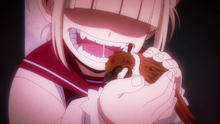
Young Himiko fascinated by gore due to having a blood-based Quirk.
Quirks are known to have a direct influence on the user's personality. For example, Himiko Toga, whose Quirk allows her to Transform into a lookalike of anyone whose blood she drinks, caused her to have an obsession with blood and gore, even when she was a child, as well as an unyielding desire to become like the people she admired. While a Quirk's influence on personality can cause the user to have trouble fitting in with others, it does seem to allow the user to use their power more naturally and effectively; Himiko's obsession with blood allows her to use her Quirk and drink blood without feeling disgusted, and without her conscience getting in the way.
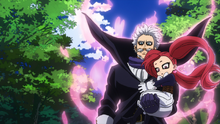
An emotion-based Quirk being used.
Another facet of Quirks is that they are affected by the user's emotions, given that they serve as a part of their physiology. This applies to some Quirks more than others, such as Blackwhip being empowered by intense emotions such as anger and hatred. Some Quirks can even be based on certain emotions entirely, such as Manami Aiba's Love, which allows her to grant a power boost to the person she loves by confessing her feelings to them.
Quirk Levels can be measured, though only Toshinori Yagi's have ever been shown, being at 15,000 AP at his peak and reaching a low point of 2,500 AP in the present.[15]
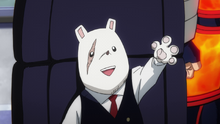
Nezu, the principal of U.A., is a prime model of an animal with a Quirk.
Although very rare, it is also possible for animals to possess Quirks, such as Nezu having a Quirk that gives him above-human intelligence,[16] the Monster Cat's Quirk that allowed it to envelop and control objects while amplified by Trigger,[17] and the Queen Bee, a parasitic bee with a Quirk that allows her to control a hive mind of other bees as well as possess the bodies of individual humans.
Vestiges[]
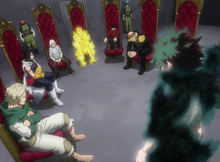
One For All: A perfect example of echoes of consciousness in the mindscape of a transferred Quirk.
Every Quirk contains an echo of the consciousness of its wielder, known as a Vestige (
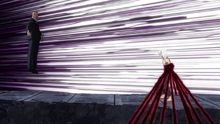
All For One's Vestige restraining Tomura.
While not much is known about these consciousnesses and what they do, they are seen to hold the same personality and memories of their original users up until they are transferred to someone else. It is shown that these Vestiges (who have been transferred to other hosts) can potentially act or override the new host body they reside in. All For One's Vestige himself holds such an immense will that he was capable of controlling Tomura Shigaraki for a lengthy time, being the only Vestige capable of such an act. During All For One's battle against Endeavor and several other Heroes, the Vestiges inside him were capable of temporarily rebelling against the Villain and hindered him until he consumed them to regain control. Later, nearing the end of his Rewind Drug-induced rampage, Hawks' Vestige was able to help stir the other Vestiges to regain control and rebel once again.

The Vestiges of the stolen Quirks rebel against All For One.
The Vestiges of One For All within Izuku Midoriya, after a direct encounter with All For One, could freely communicate with their wielder, giving him advice and able to hold full conversations. During the fight between Koichi Haimawari and Number 6, it's implied an ember of the Iwao Oguro's Vestige briefly spoke with All For One despite him transferring Iwao's Overclock Quirk to Number 6. However, a Vestige could be suppressed if the host's body overwhelms them with their own will, as Tomura did with All For One's Vestige while seizing back control of the Quirk itself. A Vestige may also be potentially destroyed if enough damage is done to them or the Quirk itself. The Vestige of New Order was completely eradicated, though a small ember of it remained to aid Izuku against Tomura.
In a similar spectacle, a Vestige of Himiko Toga remained in Ochaco Uraraka's mind after the Villain transferred all her blood into Ochaco in order to save her life (Himiko's Transform Quirk allowed her blood to become the same as Ochaco's). Eight years later, Himiko's Vestige appeared in Ochaco's dreams, with Ochaco speculating that even long after Himiko's blood had mixed with her's, a part of Himiko remained inside of her and likened it to the Vestiges inside One For All.[19]
Quirk Factors[]
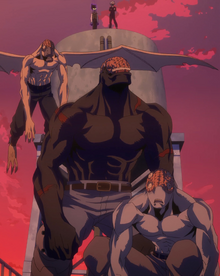
Nomu, mindless creatures spawned from multiple Quirks placed on one body.
Quirk Factors (個性因子 Kosei Inshi?), also known as Plus Alpha Elements (
Under special circumstances, a second Quirk can be added to a person's genetics. However, gaining multiple Quirks often puts immense strain on the inheritor, rendering them as mindless living dolls incapable of speaking. It was once thought that a person could only endure two Quirks if they were physically fit, as was the case with One For All users, but it turns out that they, too, suffered from the backlash of carrying two Quirks, resulting in a considerably reduced lifespan.[21]
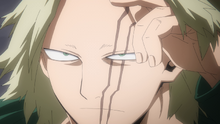
Hikage Shinomori having suffered from accelerated aging due to the burden of having two Quirks.
Presently, All For One, Gigantomachia, Kaina Tsutsumi, and Izuku Midoriya are the only known people to have been able to wield multiple Quirks without suffering from this Quirk overload. On the other hand, Number 6, Nine, and Tomura Shigaraki have been able to achieve this feat through heavy modification on the body and mind. It is potentially possible that a Quirk that can heal the body or provide more energy to the user can supersede the negative effects of holding multiple Quirks, as seen through Gigantomachia's Endurance, Tomura's Super Regeneration, and Nine's attempt to claim Cell Activation. There is also a rare chance that the initial Quirk and the bestowed Quirk may merge together, becoming a new singular Quirk, as was the case with One For All.[22]
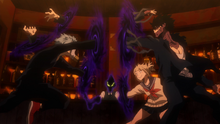
Warp Gate: A Quirk that was artificially created.
It is also possible for a Quirk Factor to not only be extracted from the body, but also replicated, enhanced, and created. Kyudai Garaki had developed a way to duplicate Quirk Factors, allowing multiple individuals to possess the same Quirk. He had also obtained a large collection of various different Quirk Factors, both through duplication and extraction from the original body, which through a procedure could be forcefully implemented into a body, as shown through the Nomu. Experimentation can also result in a Quirk Factor evolving into something new, as was the case with Eel becoming Electric Eel. Artificial Quirks can be created through the combination of multiple Quirk Factors, as seen through the creation of Warp Gate from the base of Cloud and several others. Artificial Quirks can also be created based on removing certain aspects of the original Quirk; the Decay Quirk was created as a copy of Overhaul, but with the restoration attributes removed, leaving only the destruction ability.[23]
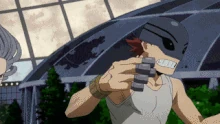
The expression of Quirk Factors interrupted.
Certain Quirks, such as Erasure, are capable of temporarily halting the expression of the Quirk Factor, rendering the Quirk unusable for a short period, but not affecting the Quirk Factor otherwise. There are other Quirks, however, that are able to directly damage the Quirk Factor of a target, preventing the Quirk from being activated until the user manages to naturally recover.
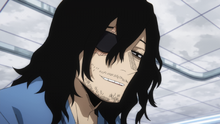
Shota's current state renders his Quirk functionally useless due to his Quirk Factor residing in his eyes.
It's possible that a Quirk Factor can be damaged beyond recovery, causing the Quirk to be permanently suppressed. The first instance was when Eraser Head was severely injured by the U.S.J. Nomu. Eraser Head's body sustained a large amount of damage, especially his face and head, and this caused his Erasure Quirk to have a much shorter time limit, as he has to blink more often because of the damage he took. This was further emphasized when he lost his right eye completely during the Paranormal Liberation War, making his Erasure nearly useless.
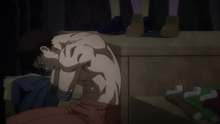
With his arms destroyed, it is impossible for Kai Chisaki to use his Quirk.
The second instance was when Overhaul had his arms destroyed by Mr. Compress and Tomura Shigaraki, making him unable to use his Quirk anymore as his arms were his Quirk Factors. There is also the Quirk-Destroying Drug, which can temporarily or permanently (depending on the variant) destroy the users' Quirk Factor, losing their ability to utilize said Quirks.
It has been shown that destroying a person's spirit would also destroy their Quirk. After All For One seemingly destroys Tomura's spirit and gains back control of his body, he notes that Decay got destroyed alongside his rage and hatred due to Izuku attacking his soul.[23]
Heredity[]
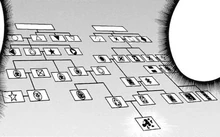
An example of Quirk heritage of two families.
Quirks are inherited genetically through what appears to be Mendelian inheritance. A child will either inherit the father's Quirk, the mother's Quirk, or a completely new Quirk formed by a fusion of the two. Depending on the parents, this new Quirk may sometimes give the appearance of the person having two separate Quirks, such as Shoto Todoroki's Half-Cold Half-Hot.
Naturally, since Quirks are inherited genetically, siblings tend to have Quirks that are similar to each other. An example of this is the Ida brothers; the older brother, Tensei has engines in his arms, while the younger brother, Tenya, has engines in his legs. Quirks in families can also have similar functions but be expressed in different ways. Both All For One and Yoichi Shigaraki had Quirks with the functions of absorbing and holding Quirks but they expressed this differently. All For One could take and give the Quirks of others but itself could not be passed on. Yoichi's Quirk could be passed onto others and imprinted the Quirks of those that had possessed it.

Ida Family, a family sharing the Engine Quirk.
Much more rarely, a child may manifest a Quirk that is completely different from anything in their genetic lineage, akin to a mutation, such as in the case of Eri's Rewind,[24] and Koki Terumoto's Darkness.[25] These Quirks are deemed as "variants" and are shown to be treated as especially unnatural. Eri's Rewind unintentionally reverted her father out of existence, causing the girl to be disowned by her mother. Koki's family reacted extremely badly when his Darkness first manifested, to the point where they all turned on him and locked him away in their house's basement.[25]
Physical abnormalities caused by Quirks can be passed on to the next generation, even if the Quirk that causes the abnormality is not passed on; Fumikage Tokoyami has a bird-like head that has nothing to do with his Dark Shadow Quirk, Koji Koda has a jagged, rock-like head that has nothing to do with his Anivoice Quirk, and Mina Ashido has a pair of horns and eyes with black sclerae that have nothing to do with her Acid Quirk. Notably however, all of these changes have had their relation to the user's Quirk called into question - Fumikage's bird head is expressed in his Dark Shadow, Koji's rocklike head grows into a horned protrusion that allowed him to telepathically issue commands using Anivoice, and Mina's horns and sclerae both change when overusing her Acid.
There is also a possibility that two people with Quirks will have a Quirkless child, such was the case with Izuku Midoriya.
Quirk Marriages[]
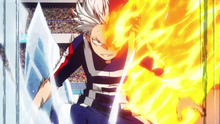
The only shown perfect child of a Quirk Marriage.
Since Quirks are passed on from parent to child, some people had taken to marrying a partner based on their Quirk, what's known as Quirk Marriages (個性婚 Kosei Kon?, lit. "Individuality Marriage").
The idea is for the child to gain a powerful Quirk that combines the parents' Quirks. A popular example of this is Shoto and his Quirk, Half-Cold Half-Hot, which is a combination of his father's fire Quirk, Hellflame, and his mother's ice Quirk, Frost. Powerful combinations, while possible, are not fully guaranteed, however, even from strong parents, seeing as Shoto was the only one of four siblings to have a powerful combination of the parental Quirks without experiencing downsides.
Due to the concept of creating children solely for the sake of experimenting with powers, Quirk Marriages were quickly deemed as unethical by society. Nowadays, they are regarded as a taboo and outdated practice.[14]
Awakening[]
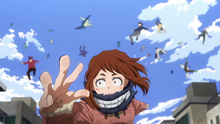
Himiko discovers she can use another person's Quirk.
After initial Quirk manifestation, it is possible for the user to undergo an "Awakening" (覚醒 Kakusei?)[26] later in life. The right emotional catalyst can cause Quirks to evolve (飛躍 Hiyaku?) on the spot, usually requiring the individual to experience intense feelings of stress, like that of a life-or-death situation.[27] This results in one's Quirk gaining a new level of strength and/or new aspects to its nature that were previously not possible.
People whose Quirks underwent an Awakening include:
- Himiko Toga, whose Transform Quirk evolved to allow her to use the Quirks of people she transformed into. This is first shown when she uses Zero Gravity while she had taken the form of Ochaco Uraraka.[28]
- Geten, whose Ice Ply Quirk evolved to be able to control the temperature of ice after Re-Destro burned himself.[29]
- Tomura Shigaraki, whose Decay Quirk reduced in power and potency after accidentally killing his family after its manifestation. During his fight with Re-Destro, his Quirk increased in power and Awakened, removing the restriction of all five fingers having to be on the target for the Quirk to take effect.[27]
- Katsuki Bakugo, after a near-death experience upon being stabbed by Tomura's Rivet Stabs, went through an Awakening causing his Explosion Quirk to become stronger, faster, and more condensed than usual, resulting in the development of Cluster.[30] This later allowed him to create explosions across his entire body using Cluster, increasing his speed and mobility while removing the need to use his hands to do so.
- Koji Koda, during the Seige on central hospital, had his horns grow in as his Quirk Awakened[31]. This allowed him to control animals telepathically, rather than having to issue verbal commands.
- Ochaco Uraraka, after Himiko Toga grievously injured her, underwent an Awakening, allowing the anti-gravity effects of her Zero Gravity to spread from one target to others she didn't touch in a domino fashion. In addition, Ochaco's Awakening removed her weight limit of three tons.[32] She can generate gravitational bubbles that make anything they touch float, while removing the need to physically touch her opponents or objects.
- Yuga Aoyama underwent an evolution that strengthened his Navel Laser Quirk following his injuries at the hands of Kunieda and made his laser beams more rapid and more potent, even to the point of glitching the Invisibility Quirk of Toru Hagakure.[33]
While never referred to as an Awakening, Izuku Midoriya unlocking the ability to use the other Quirks of One For All[34] was also triggered by intense emotion and represented a fundamental evolution of the Quirk, making it mechanically similar to a Quirk Awakening.
Awakenings are typically considered very rare, to the point that not even All For One could comprehend the concept as he witnessed the battle between Koichi Haimawari and Number 6, noticing the two exhibit such incredible power and resilience with their Quirks that he believes shouldn't be inherently possible.
In contrast to Awakenings, there are instances where people can summon an absurd amount of power in a crisis, however this only manifests when they are truly at death's door. An example of this is Izuku, who, after nearly being crushed to death by Muscular, managed to rise to his feet and operate at 100% of his power for an extended period of time, allowing him to send the Villain flying with 1,000,000% Delaware Detroit Smash.[35][36] Another example of this is Dabi, who after overusing his Blueflame Quirk for an extended period of time, despite it burning himself to a crisp, was able to manifest the ice from his mother's Frost Quirk, increasing his power capabilities while being minutes away from death.[37]
Quirk Singularity[]
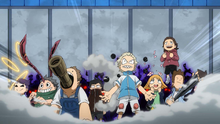
The next generation possessing stronger Quirks.
The theory of Quirk Singularity (個性特異点 Kosei Tokuiten?) is a popular line of thinking that suggests that Quirks will continue to mix together and deepen, growing in both strength and complexity with every new generation. Eventually, Quirks will develop to a point where no one will be able to control them anymore.[38]
This idea was first theorized by Kyudai Garaki, who started to see early signs of this phenomenon among the fourth generation of Quirk users. However, with the exception of All For One, no one believed his theory, and he was ostracized from society as a result.[39]
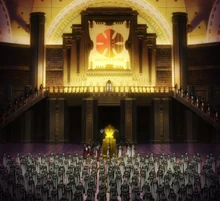
Humarise, the global anti-Quirk cult.
This theory is first mentioned by Seiji Shishikura when Present Mic notes how the Masegaki Primary School students have very powerful Quirks and have much better control over them than he did at that age. He also mentions that in this current era, the theory is viewed as fringe thinking, and is primarily followed by some cultists.[40] One of these cults, Humarise, were so indoctrinated in this belief that they committed mass terroristic acts all in service of culling the Quirk population to prevent what they believe to be the end of the world. Quirk users also joined the cult, whether that's due to a hatred for their own Quirk, giving their power and life to the cause as "penance", or simply to save their own skin.[12]
The Quirk Singularity was eventually proven true as a result of Tomura obtaining the All For One Quirk. His body began to morph and reshape to an absurd degree to reach its optimal shape that represented the user and the amount of power that resided within his body.[41]
Quirk Duplicates[]
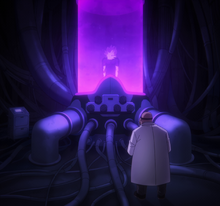
Tomura Shigaraki undergoing a Quirk transplant surgery.
It is possible through advanced scientific means to copy a person's Quirk and preserve it in a container, allowing the possibility of transferring said ability to another individual. The exact process and requirements involved in Quirk Duplication are unknown, but Kyudai has insinuated that it takes a great amount of time just to replicate a single Quirk, let alone the countless ones he had stored away in his secret laboratory.
Quirk Duplication is believed to have great potential in benefitting humanity, with Present Mic stating that it could have been applied to regenerative medical care and likens it to using "cheat codes".[42]
The process of artificially transferring a Quirk to another person requires a complex surgery, whereas the individual is rendered in stasis while the Quirk is implanted into their body. Since the strain of possessing more than one Quirk can cause the user serious problems, such as heavy drawbacks to the body, accelerated aging, or even inducing a mindless state, a person who undergoes such a process must have a body that is strong and conditioned enough to receive another Quirk, while also being compatible with the respective Quirk Factor.
A duplicate Quirk will possess the exact same abilities as the original, though not always to the same extent and quality. The Quirk-stealing ability, All For One, has been duplicated twice and both variants are considerably weaker than the original. Nine's version of All For One only allowed him to steal up to 8 Quirks, while the Villain All For One's copy of the eponymous Quirk does not grant him the same level of command over his stolen Quirks, allowing the vestiges of their past users to resist and hinder him from within.[43][44] Decay, a modified copy of Overhaul, lacks its reconstructive abilities and initially its speed, however due to a Quirk Awakening it has properties Overhaul never had, such as solipsistic destruction.
So far, Dr. Kyudai Garaki is the only known person who is capable of duplicating Quirks, as well as transferring them artificially.
Quirk Restriction Laws[]

Koichi being scolded for using his Quirk in public.
In an effort to preserve order in the superhuman society, there are several laws and procedures in place to ensure the conscientious use of Quirks. Public display of Quirks is against the law,[45] as is using them with the intention to harm other people, except in cases of self-defense, such as when one is under attack or preventing someone else from being attacked.[46] Despite this, the notion of Quirks not being used in public is sometimes ignored or overlooked, being compared to an old rule of not riding bicycles on sidewalks, although doing so would still be an infraction of the law. Certain Quirks also have more regulations than others to prevent their abuse, like Glamour.[38]
Citizens are required to have their Quirks registered with the government. It is possible for the details of a person's Quirk registration to be changed, as it is quite common for people to discover new things about their Quirk that they were previously unaware of. However, major and frequent changes are usually not allowed.
During elementary school, children receive Quirk counseling in order to learn how to use their powers responsibly and to help support their growth, since a young child's Quirk can have a large effect on their self-esteem.[47][48] Quirk counseling can also be intended to correct and reform any "deviant" behavior that is caused by one's Quirk.[49]
Despite this, Quirk counseling is not a cure-all and is not always met with success. Chitose Kizuki even highlights the major flaw with Quirk counseling is how it tries to forcibly correct any abnormalities present in children's Quirks, pressuring them to get rid of their differences rather than accepting them. Himiko Toga is a key example of this, as her fascination with blood was deemed as abnormal during her childhood and being forced to suppress this trait led to her mental instability, eventually causing her to become a Villain.[28]
In the following eight years, an expansion to Quirk counseling is started by Ochaco Uraraka, with her and her fellow Pro Heroes touring elementary schools around Japan, wishing to make Quirk counseling more accessible and likely intending to give children better guidance with their abilities.[50]
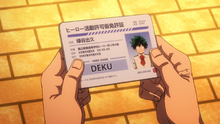
A Provisional Hero License.
Aspiring Pro Heroes undergo special education during their high school careers and receive licenses that give them the authority to use their Quirks freely. Only licensed Pro Heroes or Heroes in training with Provisional Hero Licenses are allowed to use their Quirks for things such as rescuing people or to commit bodily harm by attacking Villains.
Using one's Quirk to do such things while unlicensed is illegal and punishable by law, sometimes through hefty fines as seen with Danjuro Tobita, whose parents were forced to pay for him using his Quirk without a license, as well as unintentionally intercepting a Pro Hero from rescuing a falling victim.[51] In other cases, illegal usage of Quirks can be labelled as acts of vigilantism or even villainy and can be met with dire consequences.

The confidentiality of All Might's Quirk resulted in One For All being "one of the seven great mysteries of the world".
When it comes to Heroes, it is also possible for the specifics of their Quirks to be kept classified by their nation's government. An example of this is All Might, whose Quirk was kept secret to protect the truth of One For All. This led many people to assume it was simply a super-strength or invulnerability Quirk, while many others theorized endlessly as to what his Quirk could actually be.[52] A similar notion applied to America's No. 1 Hero, Star and Stripe, and her New Order Quirk, which was kept strictly confidential under the U.S. government. Although civilians gained a rough idea of what it was from seeing her in action in the field, with her being able to apply a rule of her choosing to anything she touched and called out the name of.[53]
Additionally, it is also possible for regular workers to use their Quirks provided they have the proper permissions and licensing. Izuku said that Ochaco could use her Zero Gravity to help with her parent's construction company by reducing prices on heavy lifting if she managed to get her Quirk licensed.[54] Furthermore, electricity-based Quirks are said to be highly valued in the job market, which is why Heroes with electric Quirks are quite rare.[55][56] This proves that people aside from Heroes can use their Quirks for work purposes.
Quirk Types[]
Quirks come in a very wide variety, as the name Quirk implies, they are unique to each individual. However, Quirks can be divided into categories based on what they do and how they function, known as Quirk Types. Some Quirks cause a permanent physical abnormality to the user's body, known as Mutant-type. Some cause the user's body to undergo a temporary physical abnormality when the power is used, known as Transformation-type. Finally, some Quirks don't cause any abnormalities to the user's physical body at all, known as Emitter-type.
Aside from the three Quirk Types, Quirks can also be categorized into Sub-Types. A Quirk can fall into a given sub-type regardless of what type it is. In other words, a given sub-type can be designated to Quirks of all three types, so long as the Quirks possess an aspect that fulfills the requirement to be considered as part of that sub-type.
Known Quirk Types[]
Emitter[]
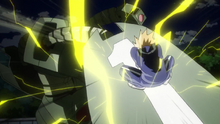
Denki Kaminari emitting electricity.
Emitter (発動 Hatsudō?)-type (also called Operative)[57] Quirks are abilities that allow the user to generate and possibly control certain things, or alter existing things around them in certain ways. The emissions of Emitter-type Quirks can have a wide variety of properties and abilities.
Emitter-type Quirks, such as Brainwashing, Explosion, and Half-Cold Half-Hot usually require a conscious effort to activate, and some, such as Erasure, even require large amounts of concentration in order for them to remain active.
Emitter-type Quirks can also have various ranges. While some users require physical contact to use them, others can have much longer ranges with no distance restrictions.
While most Emitter-type Quirk users generally have a handle on their own "emissions", it's also possible for users to hurt themselves from coming into too much contact with their Quirk. In the case of generating substances, making too much too fast or for too long can harm the user as they are using reserves from their own body, or gradually lose their natural resistance to their own harmful Quirk.
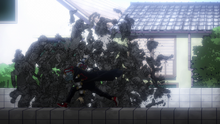
The molecular destruction of Tomura Shigaraki's Decay.
While some things produced by Emitter-type Quirks, such as the loud sound produced by Voice, have common properties, some are unique to the user, and thus have special properties, such as the ectoplasm produced by Clones. Those who alter the properties of things around them can also widely vary in effects, from molecular alteration to molecular destruction, such as Softening or Decay, respectively.
Some Emitter-type Quirks cause the user's body to take on a temporary alternation. While such Quirks would normally fall into the Transformation class, the difference is that these powers require the user to take in an outside resource in order for the Quirk to activate. Such Quirks are Sugar Rush, which requires the user to ingest sugar,[58] and IQ, which requires the user to drink tea.[59]
Emitter-type Quirks are, by a wide margin, the most common type of Quirk.
Transformation[]
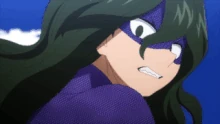
Setsuna Tokage transforming her body into pieces with her Quirk.
Transformation (変形 Henkei?)-type (also called Composite)[57] Quirks are abilities that cause the user to take on a temporary alteration of some kind. Transformation-type Quirks allow the user to temporarily "transform" their body in a variety of manners, sometimes enhancing existing features, removing features, or adding new features to the body altogether.
Transformation-type Quirks usually require a conscious effort by the user to "activate", though most users can be trained to initiate them reflexively, depending on the conditions required for activation, and practice to initiate their Quirks with greater intent and precision, such as with Edgeshot and his Quirk; he's mastered it to a point where he can change faster than the speed of sound.[60]
Transformation-type Quirks usually require a close-range proximity in order to fully utilize them in combat due to them only affecting the user's body. While Transformation-type Quirks are often quite powerful, their biggest weakness is that their effects are often temporary, and over-exertion usually leads to negative repercussions on the user's behalf. Transformation Quirks can also be limited based on the user, how resilient their body is, and the resources they have available to them (Ex. Tetsutetsu Tetsutetsu describes that his Steel Quirk softens if he doesn't consume enough iron, and suffers from iron fatigue if he maintains it for too long).[61] Some users condition their body in certain ways so that their Quirks can operate more effectively.
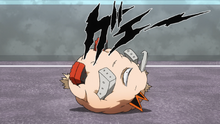
A Transformation Quirk affecting another person.
Transformation-type Quirks are the only known type of Quirk that can bestow the user attributes they do not normally exhibit by default. Because this type of Quirk combines the activation time and mutant-shape aspects of the other Quirk types, it is also often known as Hybrid or Composite.
Transformation-type Quirks generally affect the user exclusively, the only known exceptions being Seiji's Meatball[62] and Himiko's Transform.[63]
Transformation seems to be the least common type of Quirk.
Mutant[]

Mezo's Mutant Quirk gives him extra arms that he can transform into other body parts.
Mutant (異形 Igyō?)-type (also called Heteromorphic)[64] Quirks are abilities that cause the user a permanent "abnormality" directly related to their power. Mutant-type Quirks create bodily structures that grant the user more complex abilities that Emitter and Transformation Quirks cannot safely provide. Often times they will bestow prehensile appendages that the user can control or add structures to pre-existing limbs to enhance pre-existing abilities. Mutant-type Quirks even have the ability to channel certain aspects of their user through them in a similar manner to Emitter-type Quirks.
Mutant-type Quirks are also the only known type of Quirk which can be passed down through generations without necessarily bestowing the corresponding ability, such as with Fumikage Tokoyami and his bird-like head that has nothing to do with his Dark Shadow. As a result of this, while it's uncertain how common Mutant-type Quirks are, it can be safely assumed they are the most commonly inherited.
While not necessarily a weakness, Mutant-type Quirks cannot be turned off, and sometimes cause the user inconvenience due to their malformations. Such is the case with Mashirao Ojiro and his Tail Quirk, which makes it difficult for him to sit or lay down, as well as Mezo Shoji, whose Dupli-Arms Quirk makes it impossible for him to wear clothing with sleeves. Though because these Quirks are passively active, they are partially immune to Quirk-disabling effects such as that of Shota Aizawa's Erasure Quirk. Since Mutant Quirks are passively active, they are the most identifiable at a glance.

A heteromorph suffering discrimination.
Users with Mutant-type Quirks, most often known as "heteromorphs", also find themselves the most discriminated against, even by other Quirk users, due to their outer appearances. Mezo always wears a mask over his mouth to hide the scars he received as a child, and people like Chimera and Spinner are pushed toward villainy due to the prejudices they deal with due to their looks. Cults such as the Creature Rejection Clan also exist with the purpose of eradicating these heteromorphs.
Known Quirk Sub-Types[]
Accumulation[]
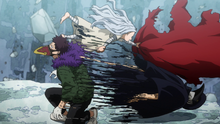
Eri's Accumulation-type Quirk kicks in.
Accumulation-type Quirks are powers that, in order to function properly, require the user to accumulate something ahead of time, such as power, energy, mass, or a particular resource. Such Quirks of this type include One For All, Stress, Rewind, Fa Jin, Fat Absorption and Shame.[65]
List of Quirks[]
List of Unnamed Quirks[]
| Quirk | Usage | User(s) | Type |
|---|---|---|---|
| Absorption and Release | 
|
Four-Eyed Nomu | Emitter |
| Air Wall | 
|
Unknown Former Hero |
Emitter |
| Attraction of Small Objects | 
|
Inko Midoriya | Emitter |
| Bullet Laser | 
|
Unknown Former Hero |
Emitter |
| Burst | 
|
Near High-End Nomu | Emitter |
| Control Horn | 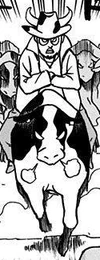
|
Cow Cowboy | Mutant |
| Fire Breath | 
|
Hisashi Midoriya | Emitter |
| Glass Manipulation | 
|
Starservant | Emitter |
| Hydra | 
|
Unknown Former Hero |
Emitter |
| Paralysis | 
|
Habuko Mongoose | Emitter |
| Power Stockpiling | 
|
Unknown former user All For One (Formerly) |
Emitter |
| Sandstorm | 
|
Snatch | Transformation |
| Scanning | 
|
Unknown Former Hero |
Emitter |
| Sludge Form | 
|
Sludge Villain | Mutant |
| Smoke | 
|
Robber Villain | Emitter |
| Storage | 
|
Hood | Emitter |
| Tongue Web | 
|
Four-Eyed Nomu | Transformation |
| Tool Arms | 
|
Chainsaw Nomu | Transformation |
| Wing | 
|
Near High-End Nomu (Formerly) |
Transformation |
List of Non-Canon Quirks[]
| Quirk | Usage | User(s) | Type |
|---|---|---|---|
| Brown Bear | 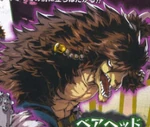
|
Bearhead | Mutant |
| Chart | 
|
Kashiko Sekigai | Emitter |
| Cleaning | 
|
Zookeeper | Emitter |
| Dust | 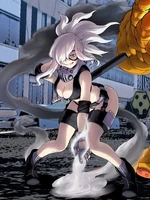
|
Dusty Ash | Emitter |
| Eruption | 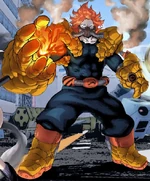
|
Volcano | Emitter |
| Fan | 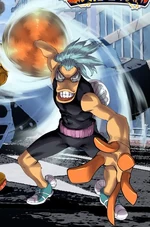
|
Gust Boy | Mutant |
| Flash Bang Sweat | 
|
Dadan Tadan | Emitter |
| Whale | 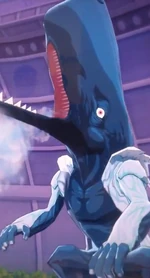
|
Curator | Transformation |
| Zombie Virus | 
|
Romero Fujimi | Emitter |
Trivia[]
- Despite Quirks being sorted under one of the three main types, Emitter, Transformation, or Mutant, they can fall under more than one category, often Mutant with either Emitter or Transformation. This is seen with characters such as Mina Ashido and Jurota Shishida whose Quirks are classified as Emitter and Transformation, respectively, but who have permanent changes to their bodies just like Mutant Quirks that work in tandem with the rest of their Quirk (Mina's skin is naturally much more resistant to acid than a normal human's while Jurota has a naturally hairy body and fangs which can be used when transformed to insulate against attacks or to bite).
References[]
- ↑ 1.0 1.1 My Hero Academia Manga: Chapter 407.
- ↑ 2.0 2.1 2.2 My Hero Academia Manga and Anime: Chapter 1 and Episode 1.
- ↑ My Hero Academia Manga: Chapter 158.
- ↑ My Hero Academia: Vigilantes Manga: Chapter 12.
- ↑ My Hero Academia Manga and Anime: Chapter 193 and Episode 90.
- ↑ My Hero Academia Manga and Anime: Chapter 232 and Episode 110.
- ↑ My Hero Academia: Vigilantes Manga: Chapter 12.
- ↑ My Hero Academia Manga and Anime: Chapter 218 and Episode 109.
- ↑ My Hero Academia Manga and Anime: Chapter 66 and Episode 36.
- ↑ My Hero Academia Manga and Anime: Chapter 312 and Episode 133.
- ↑ My Hero Academia Manga and Anime: Chapter 14 and Episode 10.
- ↑ 12.0 12.1 My Hero Academia: World Heroes' Mission.
- ↑ My Hero Academia Manga and Anime: Chapter 168 and Episode 80.
- ↑ 14.0 14.1 My Hero Academia Manga and Anime: Chapter 301 and Episode 130.
- ↑ My Hero Academia: Two Heroes.
- ↑ My Hero Academia Manga: Vol. 3, Omake
- ↑ My Hero Academia: Vigilantes Manga: Chapter 17.
- ↑ My Hero Academia Manga and Anime: Chapter 287 and Episode 123.
- ↑ My Hero Academia Manga: Chapter 431.
- ↑ My Hero Academia Manga: Chapter 135.
- ↑ My Hero Academia Manga and Anime: Chapter 304 and Episode 131.
- ↑ My Hero Academia Manga and Anime: Chapter 59 and Episode 33.
- ↑ 23.0 23.1 My Hero Academia Manga: Chapter 419.
- ↑ My Hero Academia Manga and Anime: Chapter 156 and Episode 76.
- ↑ 25.0 25.1 My Hero Academia Manga: Chapter 429.
- ↑ My Hero Academia Manga: Chapter 234.
- ↑ 27.0 27.1 My Hero Academia Manga and Anime: Chapter 234 and Episode 111.
- ↑ 28.0 28.1 My Hero Academia Manga and Anime: Chapter 226 and Episode 109.
- ↑ My Hero Academia Manga and Anime: Chapter 230 and Episode 110.
- ↑ My Hero Academia Manga and Anime: Chapter 293 and Episode 125.
- ↑ My Hero Academia Manga and Anime: Chapter 371 and Episode 152.
- ↑ My Hero Academia Manga: Chapter 393.
- ↑ My Hero Academia Manga: Chapter 400.
- ↑ My Hero Academia Manga and Anime: Chapter 211 and Episode 98.
- ↑ My Hero Academia Manga and Anime: Chapter 76 and Episode 42.
- ↑ My Hero Academia Manga and Anime: Chapter 84 and Episode 46.
- ↑ My Hero Academia Manga: Chapter 387.
- ↑ 38.0 38.1 My Hero Academia Manga and Anime: Chapter 166 and Episode 80.
- ↑ My Hero Academia Manga and Anime: Chapter 246 and Episode 113.
- ↑ My Hero Academia Manga and Anime: Chapter 270 and Episode 117.
- ↑ My Hero Academia Manga: Chapter 366.
- ↑ My Hero Academia Manga and Anime: Chapter 260 and Episode 114.
- ↑ My Hero Academia: Heroes: Rising.
- ↑ My Hero Academia Manga: Chapter 356.
- ↑ My Hero Academia Manga: Chapter 70.
- ↑ My Hero Academia Manga: Vol. 9, Omake
- ↑ My Hero Academia Manga and Anime: Chapter 22 and Episode 14.
- ↑ My Hero Academia Manga and Anime: Chapter 165 and Episode 79.
- ↑ My Hero Academia Manga: Chapter 392.
- ↑ My Hero Academia Manga: Chapter 430.
- ↑ My Hero Academia Manga and Anime: Chapter 179 and Episode 85.
- ↑ My Hero Academia Manga and Anime: Chapter 2 and Episode 3.
- ↑ My Hero Academia Manga: Chapter 331.
- ↑ My Hero Academia Anime: Episode 14.
- ↑ My Hero Academia Anime: Episode 13.
- ↑ My Hero Academia: Ultra Analysis: The Official Character Guide.
- ↑ 57.0 57.1 My Hero Academia Manga: Chapter 72.
- ↑ My Hero Academia Manga and Anime: Chapter 67 and Episode 34.
- ↑ My Hero Academia Anime: Episode 55.
- ↑ My Hero Academia Manga and Anime: Chapter 88 and Episode 47.
- ↑ My Hero Academia Manga and Anime: Chapter 37 and Episode 22.
- ↑ My Hero Academia Manga and Anime: Chapter 107 and Episode 56.
- ↑ My Hero Academia Manga and Anime: Chapter 114 and Episode 60.
- ↑ My Hero Academia Manga: Chapter 14.
- ↑ My Hero Academia Manga and Anime: Chapter 217 and Episode 100.

















